The great concept of Vata, the symbolic Ayurvedic “biological mobilizing agent,” is very broad in meaning. It encompasses many seemingly disparate meanings. In order to be understood, identified and applied for medical purposes, it must be investigated in detail in its different manifestations. Here we present the aspects of Vata from eight points of view:
- Vata in the sense of air or gas
- Vata in the sense of tastes
- Vata in the sense of the nervous system
- Vata in the sense of health
- Vata in the sense of disease
- Vata in the sense of aggravating agent
- Vata in the sense of diagnosis
- Vata in the sense of treatment
Vata in the Sense of Air or Gas
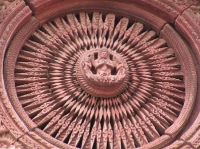 The Ayurvedic theory of matter, based upon ancient eastern philosophy, is that all objects are composed of different proportions of the “Five Elements.” The five elements are metaphysical entities. They are called Prithvi, Ap, Tej, Vayu and Akasha. Literally Prithvi means earth, Ap means water, Tej means fire, Vayu means air and Akasha means space. Each element is standardized by a formula for its fixed characteristic physical properties.
The Ayurvedic theory of matter, based upon ancient eastern philosophy, is that all objects are composed of different proportions of the “Five Elements.” The five elements are metaphysical entities. They are called Prithvi, Ap, Tej, Vayu and Akasha. Literally Prithvi means earth, Ap means water, Tej means fire, Vayu means air and Akasha means space. Each element is standardized by a formula for its fixed characteristic physical properties.
Although the metaphysical element called Vayu (air) is not the same as the physical air of the atmosphere, the two are related. Specifically, the formula of Vayu contains the same physical properties described earlier for Vata: Ruksa (dry), Shita (cold), Laghu (light), Suksma (micro-fine), Chala (vibration), Vishada (non-viscous) and Khara (harsh). In this sense, the metaphysical Air Element and the air of atmosphere, although they are not the same, are related by their shared physical properties.
The effect of the Air Element as a component of an organism, as with the effect of atmospheric air upon an organism, is to counteract greasiness and to increase dryness. The concept “counteraction of dryness by greasiness” means that the ventilation of air reduces the moisture within an object. The evaporation of this moisture occurs in an object affected by Air causes dryness. When something is dried, it becomes harsher and less sticky. In this sense the physical properties of the air formula called Ruksa (dry), Vishada (non-viscous) and Khara (harsh) are classified within the same category because they tend to occur together.
The weight or heaviness of an object depends largely upon the quantity of water or the Water Element it contains. Therefore an object affected by air is by nature reduced in water and so becomes light (Laghu). Light is the opposite of heavy.
When an object affected by air loses water, the space held by escaped water is captured by air because air is everywhere. The interior structure of an object in which air increases thus becomes more hollow and less dense. Its density is broken into minute forms that escape into the air. This condition is the physical property or state termed Suksma (microfine). Therefore it is said that Suksma (microfine) is counteractive to Sthula (density).
When an object affected by air loses water, the evaporated water at the beginning of this process moves directly into the air of atmosphere. This process is felt in the person so affected to be Shita (coldness) that is counteracting bodily Usna (heat).
Air is everywhere, and the incessant movement of air results in vibration. Following the analysis of the physical properties of the air formula, this Chala (vibration) is counteractive to Sthira (steadiness or lack of movement).
The medical word Vata literally can be translated as being air as gas because the word Vata, the Air Element and the air of atmosphere all share properties and have similar effects. They are all Vattic.
The Five Airs
Ayurveda explains that the vital air of the body has five different roles with five different names describing the effects on functions of the body. These names are called Prana, Udana, Samana, Vyana and Apana:
- Prana is the vital air that is inhaled during respiration. The Prana air plays a major role for the proper function of the heart.
- Udana is the vital air that is exhaled during respiration. The Udana air plays a major role in the function of the throat and lungs when mobilizing strength.
- Samana is the vital air that is active in the stomach and small intestine. It is involved in helping the digestive system to assimilate (carry in) the essences of food.
- Vyana is the vital air that is active in the entire blood circulation (including the lymphatic duct system) for the proper filtration and flow of the blood.
- Apana is the vital air that is active in the excretory organs (especially in the colon) for the proper excretion of stool, urine, semen and gas etc.
These vital airs, although they have different functions, are not different in the sense of their fundamental substance. They all contain the same physical properties of the air formula. It is well investigated that for the proper function of the body, they should not mix with each other or interfere with each other. Interference of their flow or function can be the cause of many physical disorders.
Vata in the Sense of Taste
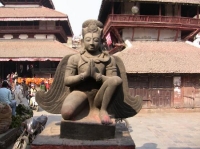 All foods, herbs or drugs have taste, and taste is the natural method by which living beings choose their foods and medicines. Ayurveda counts six tastes that are sweet, sour, salty, bitter, pungent, and astringent. Foods or herbs with sweet, sour and salty tastes, in general, are greasier. This means they contain more properties of the Water Element. Objects with more water are considered to be heavy by nature. The bitter, pungent and astringent tastes are in general dry. That means they contain less water. Objects with less water are considered to be light by nature. Sour, pungent and salty tastes, in general, cause more heat. That means they contain more Fire Element. Objects with more Fire Element are considered to be hot. Sweet, bitter and astringent tastes, in general, are cold. That means they contain more air and water. Objects with more Air and Water are considered to be colder in nature.
All foods, herbs or drugs have taste, and taste is the natural method by which living beings choose their foods and medicines. Ayurveda counts six tastes that are sweet, sour, salty, bitter, pungent, and astringent. Foods or herbs with sweet, sour and salty tastes, in general, are greasier. This means they contain more properties of the Water Element. Objects with more water are considered to be heavy by nature. The bitter, pungent and astringent tastes are in general dry. That means they contain less water. Objects with less water are considered to be light by nature. Sour, pungent and salty tastes, in general, cause more heat. That means they contain more Fire Element. Objects with more Fire Element are considered to be hot. Sweet, bitter and astringent tastes, in general, are cold. That means they contain more air and water. Objects with more Air and Water are considered to be colder in nature.
Following these rules of Ayurvedic pharmacology, bitter, pungent and astringent tastes contain more Air Element. Substances with these tastes generally strengthen the power of the air formula. Any matter that strengthens the power of the air formula, is called Vatala, meaning “an agent that increases gas or air.” The proper use of foods or medicines with bitter, pungent and astringent tastes causes balance of the Vata substance. Excessive use of them results in Vata over-balances such as nervousness and shakiness.
The sweet sour and salty tastes in general are greasy. That means they contain more Water Element. The object with more water is considered to be relatively heavier. In this sense, the sweet, sour and salty tastes are counteractive to the bitter, pungent and astringent tastes. Therefore, the excess use of sweet, sour and salty taste by nature of physical properties causes under-balance (weakness) or imbalance (irregularity) of the Vata substance.
Vata in the Sense of the Nervous System
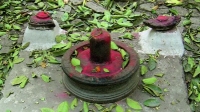 Ayurveda explains that the vital air is signified by touch because the presence of air is realized in a being only by the action of touch. Touch causes the sensations of hot and cold, pleasant or unpleasant, greasy or dry etc. Sensations result in vibrations, the reaction of the being to sensations. These vibratory reactions are a mobilization of the nervous system. In this sense, the medical word Vata is used to refer to the function of the nervous system. Diseases (rogas) caused by functional disorders of the nervous system are called “Vata rogas” For example, the classical Vata disease called Paksavata is paralysis. Spasm and pain are also Vata rogas.
Ayurveda explains that the vital air is signified by touch because the presence of air is realized in a being only by the action of touch. Touch causes the sensations of hot and cold, pleasant or unpleasant, greasy or dry etc. Sensations result in vibrations, the reaction of the being to sensations. These vibratory reactions are a mobilization of the nervous system. In this sense, the medical word Vata is used to refer to the function of the nervous system. Diseases (rogas) caused by functional disorders of the nervous system are called “Vata rogas” For example, the classical Vata disease called Paksavata is paralysis. Spasm and pain are also Vata rogas.
The nervous system is one of the three major control systems along with the venous system and the arterial system. These regulatory systems are connected with all organs and tissues of the body. They interrelate with each other according to the rules for Vata, Pitta and Kapha. The function of the nervous system controls and regulates the function of the artery system and the function of the artery system controls and regulates the function of the nervous system. The functions of the nervous system and the artery system, when combined (acting together) control and regulate the function of the vein system. Similarly, the function of the vein system controls and regulates the functions of both the nervous system and the artery system.
For demonstration, the proper use of bitter or pungent or astringent tasting foods or drugs can be used to stimulate the nervous system. The stimulated nervous system becomes more powerful to control and regulate the function of the artery system. This power is indicative of a state of balance within the nervous system. The excessive use of either bitter or pungent or astringent tasting foods or drugs results in the over-stimulation of the nervous system. If this occurs, the nervous system itself begins to move out of control. This is considered to be the state called over-balance of the nervous system.
The excessive use of sweet, sour and salty tasting foods or drugs (that are counteractive to the tastes of bitter, pungent and astringent) cause weakness in the functioning of the nervous system. The weakened or irregular function of the nervous system is defined as under-balance of the nervous system. This occurs because the bitter, pungent and astringent tastes contain more Air Element (the physical properties of the air formula) and the sweet, sour and salty tastes contain more Water Element. Following these demonstrations, it is clear that the function of the nervous system is linked to the function of the Vata substance.
Vata in the Sense of Health
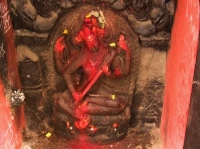 Health, in the definition of Ayurveda, means the balance of the three regulatory bodily substances (Vata, Pitta or Kapha) or the three congruent body regulatory systems, the nervous system, the venous system and the arterial system. To maintain health, the five elements–earth, water, fire, air and space–must be in proportionate amounts and be working together to keep balance in the physical construction of the body. The Vata substance represents the element air, identified by its physical properties found in the air formula. The main function of the Vata or air is to mobilize the sources of energy and the energy itself.
Health, in the definition of Ayurveda, means the balance of the three regulatory bodily substances (Vata, Pitta or Kapha) or the three congruent body regulatory systems, the nervous system, the venous system and the arterial system. To maintain health, the five elements–earth, water, fire, air and space–must be in proportionate amounts and be working together to keep balance in the physical construction of the body. The Vata substance represents the element air, identified by its physical properties found in the air formula. The main function of the Vata or air is to mobilize the sources of energy and the energy itself.
To carry out this function, the Vata substance requires proper food and behavior. The bitter, pungent and astringent tastes contain more Air Element in comparison to the other tastes. Intake of this taste in the form of foods or drugs is necessary in the proper amount to keep the balance of the Air Element in the body construction and to counteract the effects of the other tastes. The balance of the Air Element in the body results in the proper function of the nervous system, and a healthy nervous system mobilizes the physical energy and the sources of energy.
The Air Element in the form of the air of atmosphere is everywhere. The air of the body is classified according to the five significant activities mentioned earlier: air of inhaling, air of exhaling, air of assimilating, air of circulating and air of excretion. The proper function of these airs is called “Anulomana”. For health, it is very important that air–and the associated substances carried with or propelled by the airflow–moves in and out properly. Inhaled air, Prana, is very important for the proper function of the heart and brain. Exhaled air, Udana, is very important for the proper function of the throat and lungs. The air of assimilation, Samana, plays an important role for the proper movement of nutrients in the stomach and intestine. The air of circulation, Vyana, is very important for the proper function of the blood circulatory system including the liver, spleen and lymphatic duct system. And the air of excretion, Apana, is very important for the proper function of the colon, urinary system, uterus and testicles etc. The reversed function of these airs is called “Udavarta,” a disease entity that causes many physical disorders (see page 133 and page 185).
Vata in the Sense of Disease
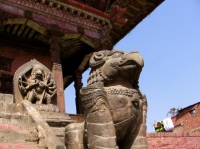 The imbalance or under-balanced Vata substance is called Vata Kshaya and the over-balanced Vata substance is called Vata Vriddhi or Kruddha Vata. With the exception of short term problems, any under-balance or over-balance of the Vata substance, as well as interference with or reversed functioning of the vital air, will cause diseases related to the nervous system. These imbalances can also affect the opposing forces of energy (Pitta) and the “sources of energy” (Kapha).
The imbalance or under-balanced Vata substance is called Vata Kshaya and the over-balanced Vata substance is called Vata Vriddhi or Kruddha Vata. With the exception of short term problems, any under-balance or over-balance of the Vata substance, as well as interference with or reversed functioning of the vital air, will cause diseases related to the nervous system. These imbalances can also affect the opposing forces of energy (Pitta) and the “sources of energy” (Kapha).
The under-balance of Vata substance means that the Air Element or the physical properties of the air formula have either become less in their natural proportion within the body construction, or else they have become less active. The over-balanced Vata substance means the Air Element or the physical proportion of the properties of the air formula has become too high in their natural proportion within the body construction, or else they have become overactive. Whenever the physical properties of the air formula go down in relative proportion, the nervous system by nature becomes less active or inactive. When there is an increase in the physical properties of air, the nervous system in the same way becomes overactive.
Under activity or over activity of the nervous system–in the body as a whole, in any part of the body or in any organ–results in many physical disorders. For example, such under activity results in sensations of weakness, weak function, irregular functioning, or no function at all in the affected part or organ. Sadness and lack of desire to talk are usually the most prominent symptoms of an under-balanced nervous system. Nervous system over-balance in the body, any part of the body or any organ causes dryness, loss of weight, loss of attachment, poor blood circulation and over activity. Dislocation, prolapse, dilation, breakage, fatigue, shaking or vibration, strong pulsation, atrophy, colic pain, strong pain, contraction, retraction, numbness, paralysis, spasms, jerking etc. are the characteristic physical symptoms.
Vata Vikara / Diseases of the Vata system
The disease processes listed here are the ones most commonly listed in the early texts. This list is by no means exhaustive.
- Breaking of the nails
- Cracking or fissures of the sole
- Pain in the sole.
- Loss of balance when walking
- Numbness of the feet
- Swelling of the ankles from gout
- Calf spasms
- Sciatica
- Swelling of the knee
- Dislocation of the knee
- Paralysis of the thigh
- Pain in the thigh
- Lameness of one leg
- Lameness affecting both legs
- Anal prolapse
- Arm pain
- Upward contraction of the testicle
- Paralysis of the penis
- Distention of the bladder
- Swelling of the hip
- Diarrhea
- Neurasthenia
- Dwarfism
- Lumbago
- Back pain
- Spondylitis
- Diaphragm spasm
- Spasm of the belly
- Heart palpitations
- Pain of the chest
- Contraction of the chest
- Atrophy of the arm
- Paralysis of the neck
- Wryneck (torticollis)
- Voice defects
- Lockjaw
- Cracking of the lips
- Breaking of the teeth
- Loose teeth
- Aphasia
- Stuttering
- Difficulty with speech
- Astringent taste in the mouth
- Loss of sense of smell
- Ear pain
- Tinnitus
- Loud hearing
- Deafness
- Paralysis of the eyebrow
- Contraction of the eyebrow
- Blurred vision
- Eye pain
- Deformation of the eyes
- Deformation of the eyebrow
- Temporal pain
- Pain of the forehead
- Headache
- Cracking of the skin on the head
- Facial paralysis
- Hemiplegia (some forms)
- Tetanus
- Convulsion
- Spasm
- Arthritis (most forms)
Symptoms of Vata Dysfunction
Besides these nerve diseases, there are some typical conditions and symptoms that are connected with nervous system over-activity. These include:
- Dryness.
- Pink/pale or blue color appearing on the face or affected area.
- Pink/pale color of the nail, conjunctiva of the eyes, or mucous membrane under the tongue.
- Pink/pale coloration in urine, stool or skin.
- Pain or symptoms worse while food is transiting the colon.
- Relief sensation when pressing on the painful area.
- Symptoms worse in the evening, at dawn or during the rainy season.
- Exhaustion, depression, restlessness, or insomnia.
- Strong pain or colic pain.
- Crawling (slow, weak) pulses.
- Symptoms worse with use of bitter, pungent or astringent tasting foods or drugs.
- Symptoms worse in cold weather or cold climate.
- Symptoms worse with constrictory food or drugs that causes poor blood circulation.
- Symptoms worse in nerve-natured persons (Vata Prakriti).
- Symptoms worse with stress distress or tension.
Reversed Action of the Five Vital Airs
In addition to the problems of under-balance or over-balance of the nervous system there also are some Vata complications caused by the interference with or reversed action of the five vital airs.
- If inhalation air (Prana) interferes with circulatory air (Vyana), it affects the brain and the sense organs of the head. That is, poor or faulty inhalation (Prana) can inhibit air supply to the head area (Vyana). This can lead to paralysis or fainting as in sudden low blood pressure or shock.
- If the circulatory air (Vyana) interferes with the inhalation air (Prana), this can cause excessive sweating and numbness.
- If inhalation air (Prana) interferes with assimilation air (Samana), it causes aphasia, stuttering and stiffness or paresis.
- If the assimilation air (Samana) interferes with the excretory air (Apana), it causes diarrhea, liver or spleen pain, and colic pain of the stomach.
- If inhalation air (Prana) interferes with exhalation air (Udana), it causes choking, headache, coldness, difficulty in breathing, dries mouth and heart diseases. For example, this can occur if someone inhales toxic gas and cannot exhale it fully.
- If exhalation air (Udana) interferes with inhalation air (Prana) it results in deafness, collapse and possibly even death.
- If the exhalation air (Udana) interferes with the excretory air (Apana), it causes vomiting and asthma.
- If the excretory air (Apana) interferes with the exhalation air (Udana), it causes delusion, weak digestion and diarrhea.
- If the circulatory air (Vyana) interferes with the excretory air (Apana), it causes vomiting, tympanitis, neurasthenia, abdominal tumor and rectal colic.
- If the excretory air (Apana) interferes with the circulatory air (Vyana), it causes diarrhea, polyuria and semenuria.
- If the assimilation air (Samana) interferes with the circulatory air (Vyana), it causes fainting, drowsiness, delirium, bodyache, weak digestion and collapse.
- If the exhalation air (Udana) interferes with the circulatory air (Vyana), it causes stiffness or paresis, weak digestion, lack of sweating, motionlessness and inability to keep the eyes open.
If the Pitta substance or the Kapha substance interferes with the vital airs they can become the cause of various heath problems. For example:
- If vital bile (Pitta) interferes with the inhalation air (Prana), it causes fainting, hot sensations, dizziness, colic pain and sour vomiting.
- If vital mucus (Kapha) interferes with the inhalation air (Prana), it causes sneezing, belching, difficulty in breathing, vomiting, and loss of appetite.
- If vital bile (Pitta) interferes with the exhalation air (Udana), it causes fainting, hot sensation, a gradual decline of the lungs, asthma and collapse.
- If vital mucus (Kapha) interferes with the exhalation air (Udana), it causes paleness in the complexion, hoarseness, difficulty in speaking, weakness, and loss of appetite and heaviness of the body.
- If vital mucus (Kapha) interferes with the assimilation air (Samana), it causes low body temperature, lack of sweating, indigestion and goose pimples.
- If vital bile (Pitta) interferes with the assimilation air (Samana), it causes excess sweating, thirst, hot sensation, fainting, and a loss of appetite.
- If vital bile (Pitta) interferes with the circulatory air (Vyana), it causes hot sensation, fatigue, jerking or spasmodic movements, paralysis, bodyache and headache.
- If vital mucus (Kapha) interferes with circulatory air (Vyana), it causes heaviness of the body, joint pain, and sluggishness within the organs.
- If vital bile (Pitta) interferes with the excretory air (Apana), it causes dark yellow urine and stool, hot sensation in the penis and anus, and menorrhagia.
- If vital mucus (Kapha) interferes with the excretory air (Apana), it causes colitis and some types of urinary disease with mucus.
Vata in the Sense of Aggravating Agent
 The nervous system can become overactive as over-balanced by Vata aggravating agents. These are primarily substances or behaviors that have or increase the physical properties, found in the air formula.
The nervous system can become overactive as over-balanced by Vata aggravating agents. These are primarily substances or behaviors that have or increase the physical properties, found in the air formula.
- Excessive or daily use of any of food or drug that is bitter, pungent or astringent in taste, alone or in combination.
- Hemorrhage or loss of blood.
- Fasting, irregular meal times or too little amount of food.
- Mental anxiety, distress or excessive thinking.
- Heavy exercise or excessive labor.
- Sleeping or sitting for a long time in cramped or otherwise bad positions.
- Withholding the urges of stood, urine, gas etc.
- Travel in vehicles that cause constant vibration of the body, or exposure to strong vibrations.
- Misuse of laxatives (page 143), enema and emetic drugs (page 145).
- Improper practice of Yoga or exercise using unnatural body positions.
- Over indulgence in sex.
- Trauma of any sort.
- Excess cold, such as cold weather or living in a cold climate.
- Excessive use of cold foods, or behaviors that have a cooling (constrictory) effect in the capillaries.
- The effect of the rainy season or excess humidity.
These Vata aggravating agents cause over-activity of the nervous system that in general manifests as neuralgia symptoms. Ayurveda presents them as fundamental causes of diseases associated with the nervous system (Vata).
Vata in the Sense of Diagnosis
 Ayurveda has classified almost all diseases within the categories of Vata, Pitta, Kapha, Vata-Pitta, Vata-Kapha, Pitta-Kapha and Vata-Pitta-Kapha. For proper diagnosis of a Vata disease, there are certain tests that have to be carried out one by one to determine a final decision. For example, colic pain, strong pain, or unbearable pain is a positive sign that a disease is caused by Vata.
Ayurveda has classified almost all diseases within the categories of Vata, Pitta, Kapha, Vata-Pitta, Vata-Kapha, Pitta-Kapha and Vata-Pitta-Kapha. For proper diagnosis of a Vata disease, there are certain tests that have to be carried out one by one to determine a final decision. For example, colic pain, strong pain, or unbearable pain is a positive sign that a disease is caused by Vata.
- Touch Test. If a painful area becomes less painful from gentle pressure, this is positive for Vata causation.
- Color Test. Presence of blue, black or pink/pale color in the affected tissue area, the complexion, or the stool, urine, nail etc. is positive for Vata causation.
- Colon activity test. If the symptoms of a disease become worse when the colon is active during digestion of food (6-8 hours after food intake), it is positive for Vata causation.
- Time Test. If the symptoms of disease worsen in the evening and/or dawn, it is positive.
- Pulse Test. If the pulse is crawling (moving weakly and slowly), it is positive.
- Seasonal Test. If the symptoms of disease are worse in the rainy season and/or winter, it is positive.
- Tastes Test. If the symptoms of disease worsen with the daily or excessive use of food or drugs or herbs that are either bitter or pungent or astringent (or combinations of them), it is positive. Feeling an astringent taste in the mouth is also positive for Vata causation.
- Climate Test. If the symptoms of disease worsen in the humidity or in an alpine climate, it is positive for Vata causation.
- Constrictory Test. If the symptoms of disease worsen while using foods, herbs or drugs that have a constrictory effect, it is positive.
- Nature Test. If the symptoms of a disease are worse in nervous thin people (Vata Prakriti) it is positive.
- Test of Mind. If the symptoms of disease become worse during anxiety, mental distress, excessive thinking or fear, it is positive.
- Skin Test. If the affected area is dry, it is positive for Vata causation.
- Swelling Test. If the affected area is swollen with gas, like a balloon, it is positive.
- Fever Test. If the temperature goes up and down sporadically or for no apparent reason, it is positive for Vata causation.
- Preference Test. If the patient prefers warmth, it is positive for Vata causation.
Vata in the Sense of Treatment
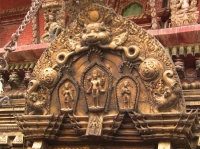 The fundamental theory of treatment concerning the nerve diseases or the condition of diseases that are classified within the character of Vata is based upon restoring balance to the over-balanced nervous system and the over-balanced physical properties of the air formula. The colon in general, contains gas that normally is excreted during peristaltic motion, and which should not be putrefactive. Excess gas within the colon and especially putrefactive gas aggravates the nervous system. This is because the physical properties of the air formula are similar to the physical properties of gas.
The fundamental theory of treatment concerning the nerve diseases or the condition of diseases that are classified within the character of Vata is based upon restoring balance to the over-balanced nervous system and the over-balanced physical properties of the air formula. The colon in general, contains gas that normally is excreted during peristaltic motion, and which should not be putrefactive. Excess gas within the colon and especially putrefactive gas aggravates the nervous system. This is because the physical properties of the air formula are similar to the physical properties of gas.
Cleansing the Colon
Ayurveda therefore emphasizes that to restore the balance of the nervous system in any part of the body, it is essential first of all to cleanse the colon with a medicated enema. Ayurvedic medicated enemas contain milk and/or oil mixed with a decoction of medicinal plants that have physical properties that counteract against the physical properties of the air formula. Ayurvedic physicians discovered and recorded that, in addition to all other treatments, medicated enemas that cleanse the colon are very effective in reducing the aggravation to the Vata substance by the toxic or excess gasses that exists when there is an over-balance of the nervous system.
The application of medical enema is no doubt effective for cleaning the colon. But, to make the treatment more efficacious and to avoid side effects from the enema, it should be applied after a short period of intake of greasy foods, and along with a hot steambath. The reasons for this are related to the basic Ayurvedic theories about physical properties. Stimulating evacuation can cause more air to accumulate in the colon, or cause the colon to become overactive and dry. This in turn can be the cause of other problems such as the diseases of the heart. To avoid these problems, application of greasy foods is prescribed before taking an enema. That is, the effect of intake of greasy foods such as oil, ghee, butter or fat is to counteract dryness. The same principle is applied when the nasal passages are cleaned with salt water, using a Neti pot. After cleaning, medicated oils are inhaled into the nose to restore balance and to moisturize after cleaning.
Steambath
The main purpose of taking a steambath is to stimulate perspiration and increase the circulation of blood. In general, when the skin is being stimulated by heat, air qualities are reduced in the body by the effect of the heat. In this sense, applications of greasy foods and use of hot steambaths both cause less air accumulation in the body during evacuation by enema, and the colon gets less chance to accumulate excess air and thereby aggravate the nervous system. The applications of grease, steam bath and medicated enema are very important for a comprehensive treatment of nerve diseases or diseases classified within the character of Vata.
Tastes which Benefit Vata
 Sweet, sour, and salty tasting foods, herbs or drugs are generally nourishing and stimulating to the activity of the artery system. A well-nourished and stimulated artery system counteracts the over-function of the nervous system because the sweet, sour and salty tastes are counteractive to the bitter, pungent and astringent tastes that aggravate the function of the nervous system. Therefore, foods, herbs or drugs that are either sweet or sour or salty (or some combination of them) are prescribed as medicines to restore the balance of the nervous system. For the sweet sour and salty tastes to be effective in restoring balance to the nervous system, they must be greasy and heavy in their physical properties. Otherwise, they cannot restore the balance. This is a basic rule of Ayurvedic pharmacology.
Sweet, sour, and salty tasting foods, herbs or drugs are generally nourishing and stimulating to the activity of the artery system. A well-nourished and stimulated artery system counteracts the over-function of the nervous system because the sweet, sour and salty tastes are counteractive to the bitter, pungent and astringent tastes that aggravate the function of the nervous system. Therefore, foods, herbs or drugs that are either sweet or sour or salty (or some combination of them) are prescribed as medicines to restore the balance of the nervous system. For the sweet sour and salty tastes to be effective in restoring balance to the nervous system, they must be greasy and heavy in their physical properties. Otherwise, they cannot restore the balance. This is a basic rule of Ayurvedic pharmacology.
Herbs that are pungent and/or bitter, if also aromatic, cause a heating or dilatory effect. Aromatic drugs are considered carminatives (page 145), because the heat generated from them expands and forces out gas accumulated in the colon. In this sense, carminative drugs or spices play a major role as an important tool that is prescribed to restore the balance of the nervous system.
Oil or oily drugs, no matter what their taste, also have medicinal value to restore balance to the nervous system. This is because the physical properties of healthy grease or oil etc. are counteractive to dryness that is one of the most important and powerful physical properties of air or Vata.
Herbs and Formulas to Treat Vata
Some common herbs used to treat Vata are:
- Ashwagandha root (Convolvulus arvensis)
- Gokshura fruit (Tribulus terrestris)
- Shatavari root (asparagus / Asparagus racemosus)
- Vacha rhizome (acorus / Acorus calamus)
- Bilwa fruit (Aegle marmelos)
- Nagaram rhizome (Indian cyperus / Cyperus pertenuis)
- Vidari tuber (Ipomea paniculata)
- Atasi oil (flaxseed / Linum usitatissimum)
- Amalaki fruit (Indian gooseberry / amla / Emblica officinalis)
- Rasna shrub (Vanda roxburghii)
In fact, any non-poisonous plant that is either sweet, sour or salty in taste, and dilatory in action, or greasy and heavy in property will have general medicinal value to subdue over-balance in the nervous system as well as to restore balance to a weakened nervous system.
In the same way, standard Ayurvedic formulas that contain the tastes and physical properties that strengthen Vata can be used as nerve restoratives. One example is the pill called Maha Yogaraja Guggulu found in the classic text. Similar to Maha Yogaraja Guggulu pills but without the minerals is called Yogaraja Guggulu. The standard dose for this remedy is 1-2 grams twice daily. Other nerve restoratives are found on page Error! Bookmark not defined.. The medicated oil calledNarayana tailam is very useful for Vata disorders.
Breathing and Medicated Snuff
The health of the nervous system also depends on proper breathing. Healthy air is sweet in taste and without smell. Therefore breathing exercises (Pranayama), when properly done, have value to restore balance to the nervous system.
The nose is a passageway to clean the head area. In some cases of head diseases classified in the character of Vata, such as paralysis, use of a nasal snuff made from carminative drugs (page 145) is prescribed. The medicated snuff causes dilatation of the capillaries of the nose and the strong sensation results in sneezing, initiating a process of nasal cleaning.
Following the logic in this background discussion about Ayurvedic principles, it should be clear that Vata in the sense of general treatment includes:
- Applications of grease
- Steambathing
- Use of enemas
- Intake of sweet, sour and salty tasting herbs and foods
- Breathing exercises
- Use of aromatic herbs
- Use of oil or oily herbs, and
- Use of medicated snuff.
0 Responses to “The Different Aspects of Vata”